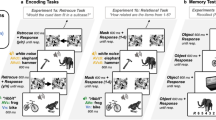Abstract
Terwijl in Bewust zien en zijn ’ 1 (Neuropraxis 1 2000) zowel de neuronale basis van visuele waarneming als de samenhang tussen gedrag van individuele zenuwcellen in de pariëtale cortex en bewuste visuele perceptie zijn besproken, ga ik in dit deel eerst nader in op de filosofische context en methodologische aspecten van het moderne neurowetenschappelijk onderzoek van bewuste perceptie. Daarna komt de temporale cortex aan de beurt en laat ik zien dat ook psychofisisch onderzoek, zeker in combinatie met beeldvormende technieken, een belangrijke rol kan spelen. Het geheel wordt afgesloten met de vaststelling dat de tijd gekomen is voor een stormachtige ontwikkeling van de cognitieve neurowetenschap.


Similar content being viewed by others
Notes
Extrastriate cortex: De primaire visuele cortex vi ziet er bij een bepaalde histologische kleuring gestreept uit en wordt daarom vaak de striate cortex genoemd. Alle visuele cortexgebieden buiten V1 noemt men tezamen extrastriate cortex (v2, v3, v3A, v4, enzovoort).
Percept: de actuele waarnemingservaring
Literatuur
Crick F.& Koch C. (1998). Consciousness and neuroscience, Cerebral Cortex 8, 97-107.
Desimone R., Albright T.D., Gross C.G. & Bruce C (1984). Stimulus-selective properties of inferior temporal neurons in the macaque, J. Neurosci. 4, 2051-2062.
Ffytche D.H., Howard R.J., Brammer M.)., Woodruff P. &Williams S. (1998). The anatomy of conscious vision: an fMRI study ofvisual hallucinations, Nature Neuroscience 1 (8), 738-742.Goldman-Rakic P.S. (1992). Working memory and the mind, Scientific American 267 (3),72-79.
Grind W.A. van de (1997). Natuurlijke Intelligentie. Amsterdam, Uitgeverij Nieuwezijds.
Grind W.A. van de (1999). ‘Evolutie van bedoelde en onbedoelde communicatie tussen dieren’, in: DierenTaal. Over communicatie bij dieren. Amsterdam/Antwerpen, K.L. Poll Stichting voor OKW, SDU-Standaard.
Grind W.A. van de & Lokhorst G.J. (in druk). ‘Hersenen en bewustzijn’, in: F. Wijnen & F.A.J. Verstraten (red.). Het brein in kaart.
Grüsser O.J. & Landis T. (1991). Visual agnosias and other disturbances of visual perception and cognition. Vision and Visual Dysfunction dl.12, Londen, MacMillan Press.
LeDoux J. (1996). The emotional brain. New York, Simon & Schuster.
Logothetis N.K. (1998). Single units and conscious vision, Phil. Trans. r Soc. Lond. B 353, 180l-1818.
Rolls E. (1990). A theory of emotion, and its application to understanding the neural basis of emotion. Cognition and emotion 4, 161-190.
Sugasi Y., Yamane S., Ueno S. & Kawano K. (1999). Global and fine information coded by single neurons in thetemporal visual cortex. Nature 400, 869-873.
Zeki S. & Bartels A. (1998). The autonomy ofthe visual systems and the modularity of conscious vision. Phil. Trans. R. Soc. Lond. B 353,1911-1914.
Author information
Authors and Affiliations
Rights and permissions
About this article
Cite this article
van de Grind, W. Bewust zien en zijn ’ 2. NEPR 4, 33–38 (2000). https://doi.org/10.1007/BF03078960
Issue Date:
DOI: https://doi.org/10.1007/BF03078960




